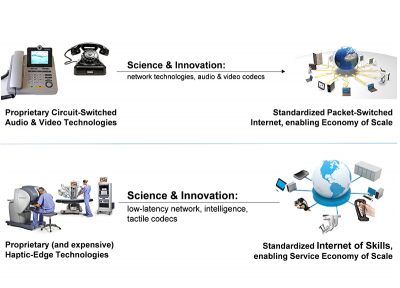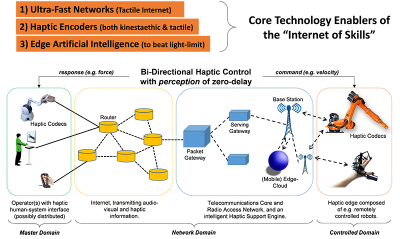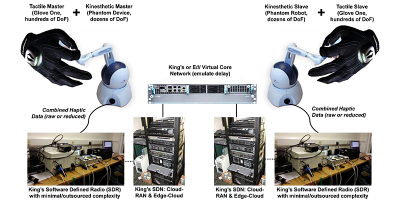Prof Mischa Dohler, King’s College London, UK; Fellow, IEEE and Royal Society of Arts
Published: 23 Jan 2017

CTN Issue: January 2017
A note from the editor:
While the rest of the world frets about ideas it is often the case that engineers and computer scientists are just charging ahead and making them reality. So it may be again, with all the worldwide talk of globalization, that the Tactile internet may quietly globalize many skills that today require physical contact between producer and consumer. Nassim Taleb in his book on the impact of improbable events, "The Black Swan", says that the critical constraint of being a dentist (and of some other professions I cant mention here) is that you must be present for your services to be of value. Well, welcome to the Tactile internet Mr Taleb! You may have to rewrite that chapter. If anyone else has anything to get off their chest, your comments are most welcome.
Alan Gatherer, Editor-in-Chief
Internet of Skills – where robotics meets AI, 5G and the Tactile Internet
Prof Mischa Dohler, King’s College London, UK; Fellow, IEEE and Royal Society of Arts

Concept Vision.
Each Internet generation was believed to be the last, with designs pushed to near perfection. The first and original Internet, a virtually infinite network of computers, was a paradigm changer and went on to define the global economies of the late 20th century. After that Internet, came the Mobile Internet, connecting billions of smart phones and laptops, and yet again redefining entire segments of the economy in the first decade of the 21st century. Today, we witness the emergence of the Internet of Things (IoT), soon to connect billions of objects and starting to redefine yet again various economies of this decade.
Underpinned by zero-delay networking paradigms in the network and the Tactile Internet at the wireless edge, above embodiments of the Internet will be dwarfed by the emergence of industrial local area networks (“Industry 4.0”) and – believed to be a true paradigm shift – by the Internet of Skills (“Human 4.0”).
By enabling the delivery of physical experiences remotely, the Internet of Skills will revolutionize operations and servicing capabilities for industries and it will revolutionize the way we teach, learn, and interact with our surroundings for consumers. It will be a world where our best engineers can service cars instantaneously around the world; or anybody being taught how to paint by the best available artists globally. At an estimated revenue of $20 trillion per annum worldwide (20% of today’s global GDP!), it will be an enabler for skillset delivery – thus a very timely technology for service driven economies around the world.
Addressing Societal Challenges.
The potential global impact of this creation would be phenomenal and instrumental in conquering some of the world’s biggest challenges. The Internet of Skills – having reached widespread adoption or being deployed at needs – will enable important disaster operation applications such as remote monitoring/surgery of people in need (e.g. applicable in Ebola hit areas); it will enable remote education (e.g. a child in Gaza is taught painting); it will enable industrial remote decommissioning and servicing capabilities (e.g. the remote repair of a broken car in Africa); among other important applications.
Take the example of the United Nation’s Ebola response: We are confident that some of the basic and frequent manual operations like spraying antiseptics on equipment and healthcare workers, communicating with patients through gestures, pictures, or animations can be done using commercially available light tactile robots. Medical experts will move the hands and grippers of an exact replica of the remote robot to send commands and receive feedback via the Internet of Skills. This will allow aid workers and medical experts to contribute to the Ebola response operation without risking their own lives, or bringing the virus back home.
Take the example of remote servicing: Operational costs (OPEX) are one of the largest expenditures for industries to date, with inefficiencies due to sub-optimal/wrong skill being one of the largest contributors. The Internet of Skills will allow matching specific needs in one physical location with the best skill in another location. Broken cars and airplanes can thus be serviced remotely; industrial plants inspected and repaired; high value manufacturing supervised – all in a significantly more efficient and effective manner, with minimal carbon footprint.
The Internet of Skills will thus be an enabler for remote skillset delivery and thereby democratize labor the same way as the Internet has democratize knowledge.
Technical Ambition.
Whilst haptic communications has been around for a long time [1] and the communications principles of the zero-delay Internet/Tactile Internet have been laid out in e.g. [1]-[6], the design of an Internet of Skills requires some ground-breaking cross-disciplinary approach in combining electrical engineering (communications, networking), computer science (artificial intelligence, data science) and mechanical engineering (kinesthetic robotics, tactile) to answer fascinating scientific questions around the viability of the above vision.

To accelerate the design of the new Internet of Skills, we aim to borrow insights from the development of today’s Internet. Indeed, as shown in the adjacent figure, the Internet took several decades of networking and codec innovation to transit from a heavily proprietary circuit-switched audio/video connectivity paradigm to today’s standardized packet-switched Internet enabling economies of scale.
Similarly, it is our ambition to lay foundational blocks in integrated end-to-end low-latency networking and haptic codec design to enable a similar transformation from today’s proprietary and expensive haptic edge-technologies to a truly global, standardized and scalable Internet of Skills.
Technical Realization & Challenges.
The designed network has to have the following characteristics: i) be ultra-reliable since many critical tasks will be executed remotely; ii) be of zero perceived delay since the transmission of kinesthetic (movement) data requires closed control loops to support action and reaction and long delays yield system instabilities; and iii) rely on cheap edges to enable true scale.
Illustrated in the adjacent figure, the actual technology thus needs to be innovated around three major areas: 1) network, 2) artificial edge-intelligence (AI), and 3) standardized haptic codecs. That would allow a reliable haptic experience around the globe, i.e. a true Internet experience. In more detail:
Networks are vital in guaranteeing the lowest possible delay possible whilst being extremely reliable and robust. End-to-end path reservation through network slicing enabled by software define networking (SDN) technologies will play an instrumental part in this. Furthermore, the tactile internet will be instrumental in guaranteeing minimum delay and strong robustness over the wireless edge. And, some fundamental architecture changes are required to enable low delay; along with many other networking transformations. In the context of 5G, this translates to the development of a new air interface which enables much shorter transmission time intervals (TTIs) and also offers much stronger reliability through various diversity approaches. Reliability can be improved further by decoupling the uplink and downlinks which requires a complete rethink in terms of radio access network design in 5G. Last but not least, the community may consider moving packet gateway functionalities closer to the edge as otherwise the stringent delay budgets cannot be met.
AI, together with networks, play an instrumental role in giving the perception of zero-delay networks. Indeed, one ought to use model-mediated teleoperation systems to have AI predict movement on the remote end and thus give enough time for the signal to reach the other side of the planet. The haptic control loops typically require a delay of 1-10ms, which translates to 100-1000km range under typical networking conditions; a range which can be extended by model-mediated approach to the tens of thousands of kilometers needed to cover the entire planet. Open research problems here pertain to environment modeling (geometry and physical properties); stable force rendering on the master side; standardized database of environmental models and cloud placement of intelligence and functionalities.
Finally, the haptic codecs will enable scale in the future as it will avoid vendor lock-ins. Here, we envisage the combination of tactile (touch) and kinesthetic (movement) information into the already available modalities of video and audio. Open challenges here are to develop a haptic mean opinion score (h-MOS); find trade-offs for joint tactile and kinesthetic information; trade-off studies for integration with other codecs; and possibly see if we could use compressed sensing solutions.

All these exciting developments are being tested in our 5G lab at King’s, as shown in the adjacent picture. As a community, much of the work is also carried out by various standardization bodies. You are most welcome to join us at the IEEE 5G Tactile Internet working group [7] as well as the overall 5G Roadmap [7][8] which we are currently developing.

Acknowledgements.
This work and vision is being carried out by a wide range of people, including but not limited to Dr Toktam Mahmoodi, Dr Maria Lema, Dr Oliver Holland, Prof Hamid Aghvami (all King’s College London); Dr Peter Marshall, Dr Joachim Sachs (Ericsson); Prof Gerhard Fettweis, Prof Frank Fitzek; Dr Meryem Simsek (all TU Dresden); and Prof Eckehard Steinback (TU Munich).
References
- G Fettweis, H Boche, E. Steinbach, et al. “The Tactile Internet,” ITU-T Technology Watch Report, August 2014; http://bit.ly/1BvAhlr.
- M Dohler, G Fettweis, “The Tactile Internet – IoT, 5G and Cloud on Steroids,” Telefonica Guest Blog Post, 30 October 2014, >200k views; http://bit.ly/1BpOG3H.
- G Fettweis, “The Tactile Internet: Applications and Challenges,” IEEE Vehicular Technology Magazine, vol.9, no.1, March 2014; http://bit.ly/1wXjwks.
- A. Aijaz, Mischa Dohler, A.H. Aghvami, V. Friderikos, M. Frodigh, “Realizing The Tactile Internet: Haptic Communications over Next Generation 5G Cellular Networks,” IEEE Wireless Communications (Magazine), in press.
- M. Simsek, A. Aijaz, Mischa Dohler, J. Sachs, G. Fettweis, “5G-Enabled Tactile Internet,” IEEE JSAC, in press.
- “An Internet of Skills, where Robotics meets AI and the Tactile Internet,” Plenary Keynote at IEEE ICC 2016, 26 May 2016, Kuala Lumpur, Malaysia, [PDF].
- The IEEE 5G Initiative; available under 5G.ieee.org.
- 5G in-depth training course; http://www.5g-courses.com.
Statements and opinions given in a work published by the IEEE or the IEEE Communications Society are the expressions of the author(s). Responsibility for the content of published articles rests upon the authors(s), not IEEE nor the IEEE Communications Society.


